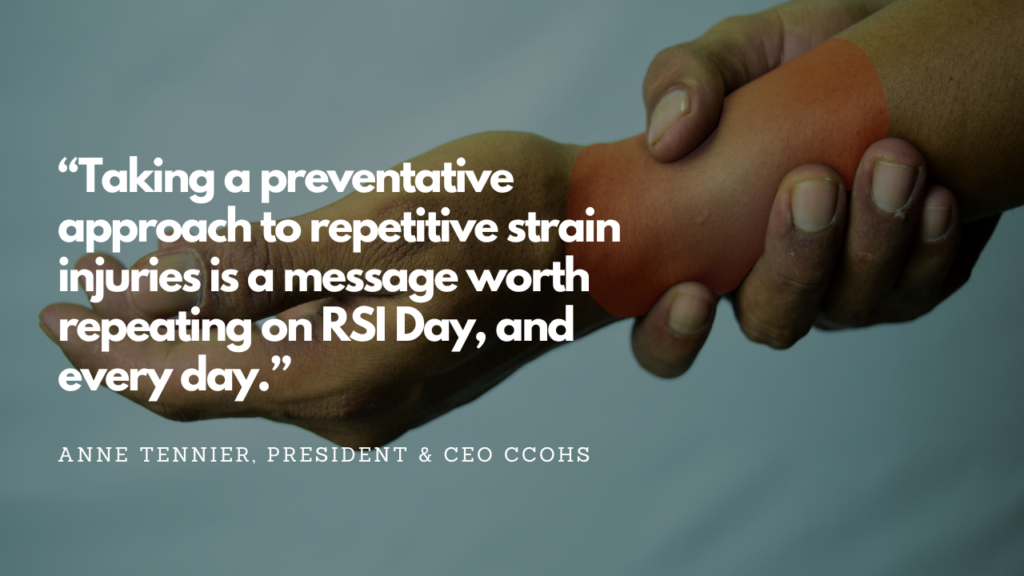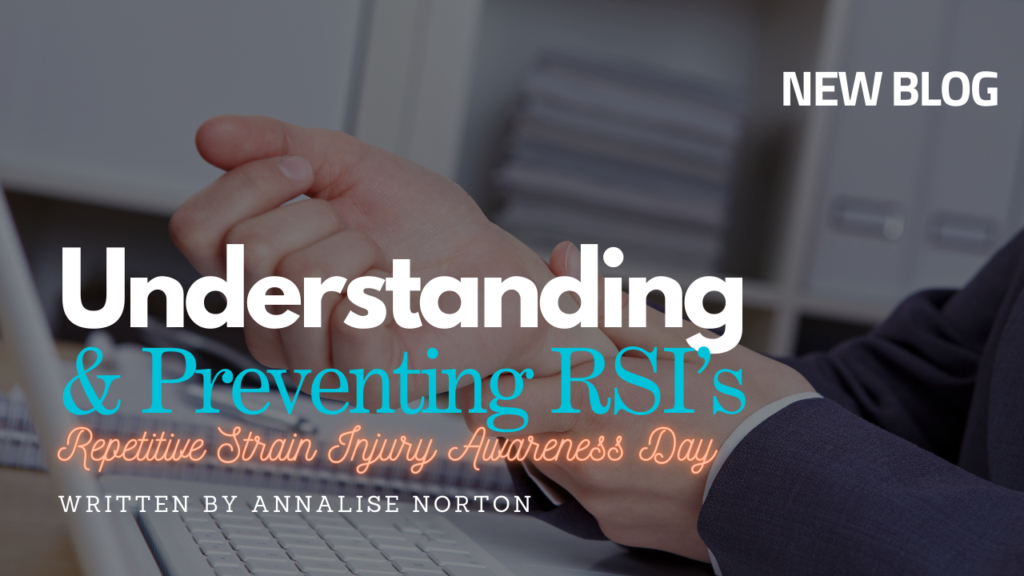Repetitive Strain Injuries (RSIs) are a growing concern in our modern, digitally driven world. On this International Repetitive Strain Injury Awareness Day, it’s essential to raise awareness about the significant impact of these injuries and share strategies for prevention and recovery. Whether it’s from long hours spent typing at a keyboard, using a smartphone, or performing manual Labor, RSIs affect millions of people worldwide. It is crucial to not only highlight the nature of RSI’s but also explore evidence-based strategies to prevent and manage these injuries effectively.
What are Repetitive Strain Injuries (RSIs)?
Repetitive Strain Injuries are a group of musculoskeletal disorders that develop because of repetitive motion or sustained awkward postures. These injuries are commonly associated with repetitive tasks that involve the same muscle groups or joints over extended periods. Symptoms can range from mild discomfort to severe, chronic pain, and if left untreated, they may result in long-term disability.
RSIs are often seen in individuals who perform tasks that involve repetitive movements, such as typing, using a mouse, assembling products, or even physical tasks like lifting or stretching. While the term “RSI” is widely used, these injuries can be more accurately classified as musculoskeletal disorders (MSDs) or overuse injuries, affecting tendons, muscles, and nerves.
The Prevalence of RSIs
According to a study published in the Cochrane Library, (click here) RSIs are among the most common work-related injuries worldwide. In fact, a significant proportion of workers in sectors that demand repetitive motions report symptoms that align with RSIs. This includes office workers, factory workers, and those in service industries, with certain age groups being more vulnerable. The global prevalence has led to an increased focus on finding effective prevention methods and treatment options for those affected.
The National Centre for Biotechnology Information (click here) reports that RSIs can have a severe impact on quality of life, causing both physical and psychological distress. In the workplace, they are responsible for considerable absenteeism, decreased productivity, and increased healthcare costs.

Risk Factors for RSIs
While RSIs can affect anyone, several factors may increase the likelihood of developing these injuries, including:
- Repetitive Movements: Constantly performing the same motion, especially for prolonged periods, increases strain on muscles and joints.
- Poor Ergonomics: Working in awkward or uncomfortable positions can put excess pressure on muscles and ligaments.
- Insufficient Rest and Recovery: Without adequate breaks, muscles and tendons do not have time to recover and are more likely to suffer from microtrauma.
- Age: Older individuals may have decreased muscle flexibility and joint health, making them more susceptible to RSIs.
Pre-existing Conditions: Those with existing joint or muscle issues may be more prone to strain injuries.
Prevention: Ergonomics and Lifestyle Adjustments
Prevention is the key to reducing the impact of RSIs, and addressing risk factors before they lead to injury is essential. As an exercise physiologist, I emphasize the importance of both physical conditioning and environmental adjustments. Here are some practical strategies for preventing RSIs:
-
- Workstation Ergonomics: Adjust the height of your chair, desk, and monitor to ensure proper posture while sitting. Your elbows should be at a 90-degree angle when typing, and the top of the monitor should be at or slightly below eye level.
- Movement Breaks: Take short breaks every 30 minutes to stand, stretch, and walk around. This helps prevent muscle stiffness and promotes circulation.
- Strengthening and Stretching: Regular exercises that strengthen the muscles involved in repetitive movements can reduce the risk of injury. Stretching can also improve flexibility and reduce muscle tension. For example, wrist stretches for office workers or shoulder exercises for those lifting heavy items can go a long way in reducing strain.
- Ergonomic Tools: Use ergonomic tools like wrist rests, supportive chairs, and adjustable desks to encourage proper posture and reduce strain on the body.
Conclusion: Raising Awareness for Better Prevention and Care
International Repetitive Strain Injury Awareness Day serves as a reminder of the importance of acknowledging and addressing RSIs in our communities. Whether you’re an office worker, a manual labourer, or a professional in any other field, understanding the risk factors and adopting preventative measures can drastically reduce your chances of suffering from these debilitating injuries.
The combination of proper ergonomic practices, regular movement, and strength conditioning act as the most effective way to prevent RSIs. Awareness, education, and proactive management are critical in combating this common but preventable issue.
Written By Uplift EP, Annalise Norton


